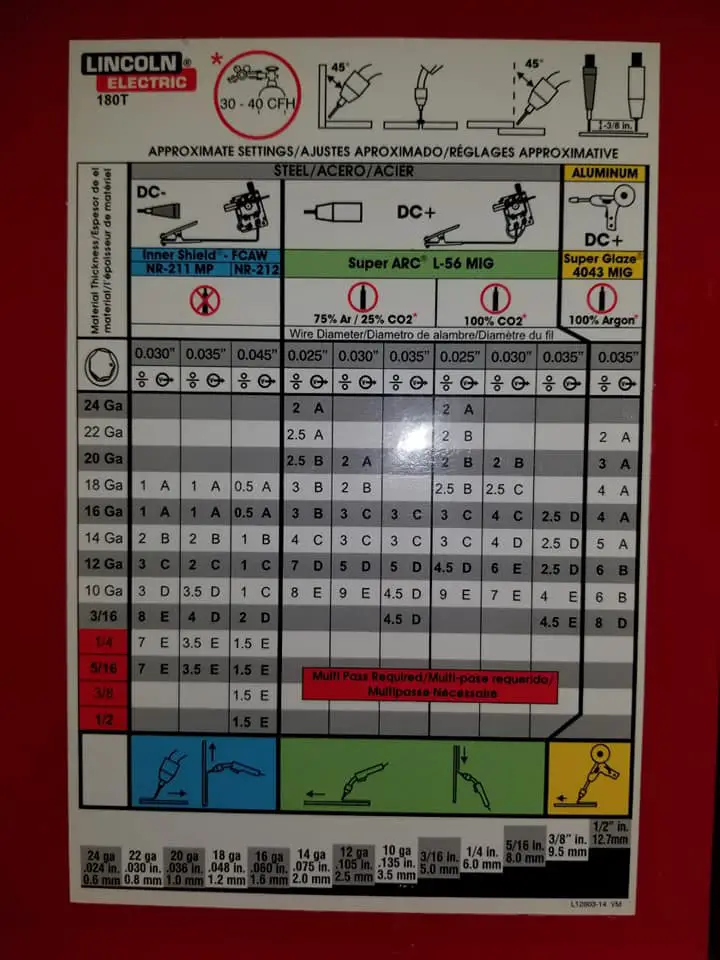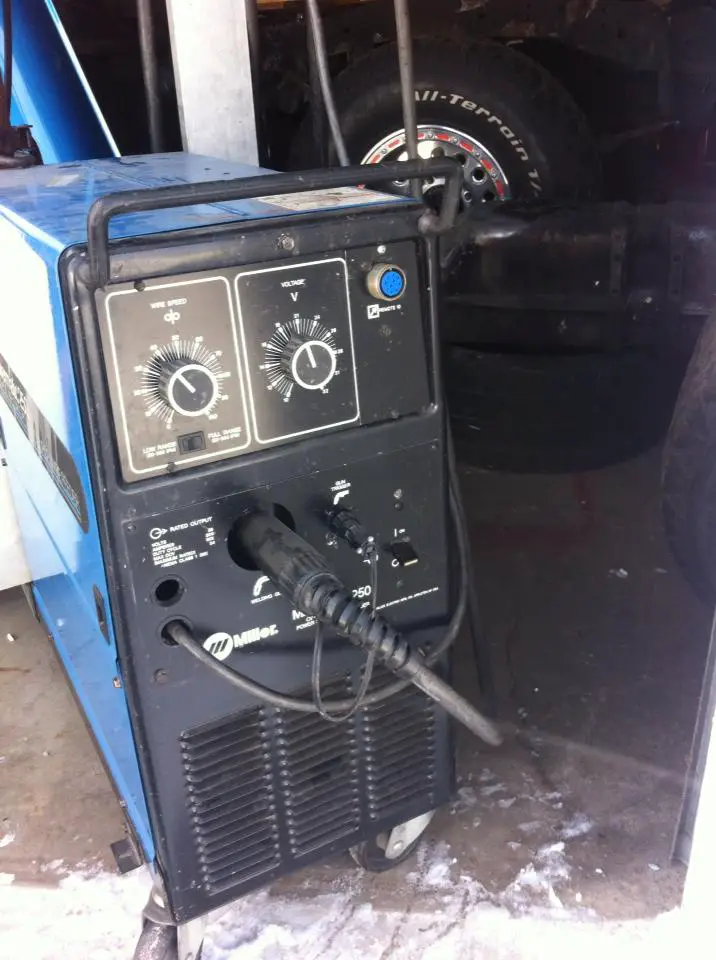Most welding machines work by producing extreme heat. The heat melts metal, which bonds as it cools. Yet, welding machines come in various designs to suit different types of welding.
An arc welding machine, or welder, is designed to create an electrical arc. The power source sends electricity through the electrode. The metal that you intend to work on is grounded. When the electrode touches the metal, it completes a circuit.
The flow of electricity through the circuit generates heat. The heat turns the metal or alloys into a molten state. The materials bond as they cool and turn from a molten state to a solid state.
The exact process will vary depending on the type of welding machine that you use.
Table of Contents
1. Setting Up the Machine
Most MIG welders include at least three settings. You need to adjust the amperage, wire feed speed, and gas flow rate.
The gas flow rate is set on the regulators on the shielding gas tank. You need to turn the valve to adjust the flow of shielding gas.
The typical gas flow rate is between 20 and 25 cubic feet per hour (CFH). If the weld pool appears porous, you need to increase the flow.
The amperage and wire feed speed are set on the machine. The amperage is set based on the thickness of the filler wire that you use:
- 0.023 inches – 30 to 130 amps
- 0.030 inches – 40 to 145 amps
- 0.035 inches – 50 to 180 amps
- 0.045 inches – 75 to 250 amps
TIG welders include different settings. You need to set the polarity and the amperage. The polarity options include alternating current (AC) and direct current (DC).
DC power is used for TIG welding stainless steel, steel, and iron alloys. AC power is needed when TIG welding aluminum.
The alternating current helps remove aluminum oxide on the surface of the aluminum. Removing the oxide ensures a cleaner joint with less porosity, making it less likely to crack under stress.
TIG welding machines also include settings for adjusting the frequency and pulse of the arc. The wavelength settings allow you to narrow or widen the shape of the arc cone or increase or decrease its force.

2. Grounding the Metal
Arc welding requires you to ground the metal. A ground clamp is attached to the base material you’re working with.
The clamp includes a wire connecting to the welding machine, making it part of the circuit created by arc welding. Without a complete circuit, you’ll fail to generate an arc.
3. Using an Electrode
An electrode is essential to the welding process when utilizing arc welding machines. This welding tool is a conduit for the electric current to melt and fuse the metal pieces. To start the process, you position the electrode to touch the surface of the metal you want to melt. Ensuring that the electrode is clean and appropriately aligned with the workpiece for precise welding is crucial.
Usually, the electrode is made of a material that easily conducts electricity, such as copper or aluminum. It’s often covered with a flux material which, when exposed to the welding heat, produces a gas to shield the weld area from the oxygen and nitrogen in the air. This shielding gas helps stabilize the electric arc and protects the molten metal from oxidation and other atmospheric contamination.
4. Forming an Arc
Once the electrode touches the metal, the next step in the arc welding process is to pull the electrode slightly away from the metal workpiece. This distance should ideally be between two to four millimeters. This is a crucial step, as it is during this movement that the electric arc is created.
The electric arc formation happens when the electrode is pulled back and the electrical circuit opens. At this point, the voltage across the gap is high enough to ionize the atoms in the air, which generates an electric spark that crosses the gap. This electric arc is incredibly hot, reaching up to 36,000 degrees Fahrenheit. This heat is sufficient to melt the electrode and the workpiece, forming a molten pool where the weld is desired.
As soon as the arc forms, the temperature increases instantaneously, melting the flux coating of the electrode and generating the shielding gas. The combination of heat, ionized gas, and shielding gas makes it possible to melt and join metal pieces, which upon cooling, forms a solid bond known as the weld bead. Maintaining a stable arc and steady hand throughout this process is crucial for consistent and high-quality welds.
5. Melting the Metal
The metal starts melting almost immediately after you start the electrical arc. The filler metal or electrode also starts to melt. The two materials create a weld pool, which is a puddle of molten material.
Most metals start fusing with the filler metal at around 3,000 degrees Fahrenheit. However, some metals have a much higher or lower melting point.
Attempting to bond metals with vastly different melting points can be challenging. You risk overheating the material with a lower melting point. The melting points for different metals include:
- Stainless steel – 2,500 to 2,785 degrees Fahrenheit
- Nickel – 2647 degrees Fahrenheit
- Cast iron – 2,200 degrees Fahrenheit
- Copper – 1980 degrees Fahrenheit
- Lead – 622 degrees Fahrenheit
The filler metal selection is incredibly important when working with metals of varying melting points. For example, a nickel-based filler material is often used when fusing carbon steel with copper or other materials with much lower melting points.
The molten material eventually cools and hardens, creating the weld joint that bonds to the two metals.
6. Using a Shielding Gas
A shielding gas protects the work materials from exposure to the atmosphere. Oxygen and other types of gases can negatively impact the quality of the weld. Environmental exposure can weaken the joints and make them more likely to crack.
Common shielding gases include:
- Oxygen
- Carbon dioxide (CO2)
- Argon
- Helium
Argon is the most used shielding gas. It’s an inert, odorless, colorless gas. Carbon dioxide offers deeper penetration but creates a rougher weld.
A combination of argon and carbon dioxide is a common choice as it helps create more visually appealing joints with less spatter than pure CO2.
Gas tanks containing the shielding gas are set up near the work area when using MIG welding or TIG welding. Stick welding uses a consumable electrode coated in flux, which acts as the shielding gas.
You must ensure the work area has proper ventilation due to potentially flammable and combustible gases.
Types of Welding
The two most common forms of welding include arc welding and torch welding. Torch welding uses a handheld torch to melt the work materials and filler rods.
Arc Welding
Arc welding involves using an electrode to create an electrical arc that achieves extremely high temperatures. There are also different types of arc welding, including:
- Gas metal arc welding (GMAW)
- Gas tungsten arc welding (GTAW)
- Shielded metal arc welding (SMAW)
Gas metal arc welding (GMAW) is called metal inert gas (MIG) welding. MIG welding is considered one of the easiest, especially tack welding methods.
GMAW uses a consumable electrode. The electrode is typically made of a solid metal wire. The wire melts, acting as a filler for the welding process. The machine continuously feeds the wire through the welding gun.
GMAW also involves the use of shielding gas. This may include a mixture of oxygen, argon, helium, and other gases.
The shielding gas shields the work materials from oxygen and the surrounding environment. Without shielding gas, the weld becomes exposed to oxygen, which leads to oxidation and increased porosity.
Gas tungsten arc welding (GTAW), or tungsten inert gas (TIG) welding, is another common type of arc welding. The welding gun includes a non-consumable tungsten electrode instead of a consumable wire.
A separate filler rod is held with your other hand. Holding the electrode with one hand and the filler rod with the other increases the challenge of learning to use TIG welding compared to MIG welding.
Shielded metal arc welding (SMAW) is also commonly called stick welding. It includes a consumable electrode rod instead of a wire.
The rod is coated in flux, which is a welding agent. It aids the flow of molten metal during the welding process and shields the weld pool. It eliminates the need for a shielding gas, as the flux protects the weld from the atmosphere.
- Can Weld Up to 1/4" Mild Steel
- 20% Duty Cycle at 90 Amps
- 115V Supply Only
- Includes 10 ft MIG Gun and 10 ft Work Cable with Clamp
- 115V or 230V Input Supply Input
- Extremely Lightweightt 18 lb with Adjustable Shoulder Strap
- Roll Cage Design
- Large TFT Screen
Weldpro 200 Amp Multi Process Welder
- 3 Year Warranty
- MIG, Stick, and TIG from One Unit
- Simple Digital Display
- Lightweight at only 30 lbs
Torch Welding
Torch welding involves the use of a flame instead of an electrical arc. It’s also called oxy-acetylene welding, as it requires oxygen and acetylene.
Oxy-acetylene torches don’t reach the same temperatures as arc welding machines. The maximum temperature of the flame is typically around 6,000 degrees Fahrenheit.
Torch welding also requires the use of a filler rod. You hold the filler rod with one hand and the torch with the other. As with TIG welding, the filler rod and the base materials fuse as the temperatures rise and cool.
Components of a Welding Machine
The components of a welding machine vary depending on the welding process. However, most arc welders include at least the following parts:
- Power supply
- Handle or gun
- Electrode
- Filler metal
A power supply is needed to provide electricity to the electrode. The electrode may be consumable or non-consumable. Consumable electrodes act as filler metal.
Consumable electrode wires are used in MIG welding, while stick welding uses electrode rods. TIG welding has a non-consumable electrode and a separate filler metal.
A welding torch includes different components, including the torch itself and a power supply.
A welding torch often includes a handle and a long metal tube that bends near the tip. The handle may also include an oxygen valve and an acetylene valve. Otherwise, gas flow is controlled via regulators on the gas cylinders.

Conclusion
Welding machines are not overly complicated. Arc welding machines include a power supply, an electrode, and a grounding clamp.
The grounding clamp clamps to your workpiece. The power supply charges the electrode. When you touch the electrode to your workpiece, you complete the circuit. Pull away the electrode a few millimeters to start the welding process.
You’ll also need to learn to maintain your welding machine if you intend to keep using it. Always take the time to clean your machine when you’re done using it. You should also review the instruction manual for any additional maintenance tasks.




